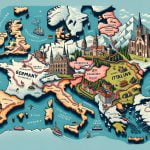Are you considering a trip from Germany to Italy? Whether you’re planning a leisurely vacation or an adventurous backpacking journey, traveling from Germany to Italy offers an exciting and diverse experience. From the enchanting landscapes of the Black Forest in Germany to the historic ruins of Rome, Italy, there is a myriad of options to explore and discover along the way.
Embarking on a journey from Germany to Italy opens up a world of cultural experiences, culinary delights, and breathtaking scenery. This article is designed to guide you through the best modes of transportation, must-visit cities and attractions in both countries, tips for planning your perfect itinerary, cultural and culinary highlights along the way, packing essentials, budget-friendly accommodation options, and safety tips to ensure a smooth and enjoyable travel experience.
As we delve into this comprehensive guide, get ready to be inspired by the wonders of both Germany and Italy. Whether you are drawn to the medieval charm of Rothenburg ob der Tauber or eager to sample authentic pasta in Florence, join us as we embark on an unforgettable journey through two European gems.
So pack your bags and prepare for an adventure like no other as we explore everything from scenic train rides through the Alps to wandering through ancient Roman ruins.
Best Modes of Transportation From Germany to Italy
When it comes to traveling from Germany to Italy, there are several modes of transportation that you can consider. Each mode has its own advantages and can cater to different travel preferences, budgets, and schedules. Whether you prefer the convenience of flying or the scenic route of train travel, here are some of the best modes of transportation from Germany to Italy.
By Plane
For travelers looking for a quick and efficient way to travel between Germany and Italy, flying is often the best option. With multiple airports in both countries offering regular flights, you can easily find direct routes from major cities like Munich, Berlin, Frankfurt, Rome, and Milan. The flight duration is usually around 1-2 hours, making it a time-saving choice for those with limited vacation time.
By Train
Train travel offers a charming and scenic way to journey from Germany to Italy. The routes showcase breathtaking landscapes as the train passes through picturesque towns and countryside. High-speed trains like the EuroCity connect cities such as Munich, Verona, Venice, Florence, and Rome efficiently. This mode of transportation allows travelers to relax and enjoy the views while avoiding traffic congestion and parking hassles.
By Car
For those who prefer flexibility and independence in their travels, driving from Germany to Italy can be an appealing option. The road trip allows for spontaneous stops at charming villages and scenic spots along the way. Travelers can also explore lesser-known destinations that may not be accessible by other modes of transportation. However, it’s important to consider factors such as tolls, fuel costs, driving regulations in each country, and potential language barriers when navigating roadways.
No matter which mode of transportation you choose for your travel from Germany to Italy – whether by plane, train or car – each offers its own unique experience that contributes to the overall journey across these two incredible European countries.
Must-Visit Cities and Attractions in Germany
Germany is a country filled with history, culture, and beautiful landscapes. As you travel from Germany to Italy, be sure to make some time to explore the must-visit cities and attractions in Germany. One of the top cities to visit is Berlin, the capital of Germany. Known for its vibrant art scene, historical landmarks such as the Berlin Wall and Brandenburg Gate, and bustling nightlife, Berlin offers something for every type of traveler.
Another city not to be missed is Munich, located in southern Germany. This city is famous for its annual Oktoberfest celebration, but there is much more to see and do in Munich. Visitors can explore the historic Marienplatz, visit world-class museums like the Deutsches Museum, and even take a day trip to Neuschwanstein Castle, a fairytale-like castle nestled in the Bavarian Alps.
When it comes to attractions in Germany, the Black Forest is a must-see destination. This picturesque region is known for its dense forests, charming villages, scenic hiking trails, and of course, the traditional cuckoo clocks. For those interested in history and architecture, a visit to Cologne Cathedral should also be on your itinerary. This stunning gothic cathedral is a UNESCO World Heritage site and is an iconic symbol of German religious heritage.
As you travel from Germany to Italy by land or air, consider adding these unique cities and attractions to your itinerary before continuing your journey southward through Europe.
Must-Visit Cities and Attractions in Italy
Italy is a diverse country with a rich history and stunning landscapes, making it a top destination for travelers from Germany. From the ancient city of Rome to the romantic canals of Venice, Italy offers an abundance of must-visit cities and attractions that will leave any traveler in awe.
One must-visit city in Italy is Rome, often referred to as the “Eternal City.” It is home to iconic landmarks such as the Colosseum, the Roman Forum, and the Vatican City. Travelers can immerse themselves in centuries of history as they explore these ancient sites and marvel at the architectural wonders that have stood the test of time.
Another popular destination in Italy is Florence, known for its Renaissance art and architecture. The city is home to renowned museums such as the Uffizi Gallery and the Accademia Gallery, where visitors can admire masterpieces by artists like Michelangelo and Botticelli. The charming streets of Florence are also filled with beautiful cathedrals, historic palaces, and bustling piazzas.
For those seeking natural beauty, a visit to the Amalfi Coast is a must. This stunning coastline features picturesque cliffside villages, turquoise waters, and dramatic coastal scenery. Travelers can take in panoramic views from scenic viewpoints or relax on one of the region’s many beaches.
These are just a few examples of the incredible cities and attractions that await travelers making their way from Germany to Italy. Each destination offers its own unique blend of history, culture, and natural beauty, ensuring that every traveler will find something to love about this captivating country.
| Must-Visit Cities | Attractions |
|---|---|
| Rome | Colosseum, Roman Forum, Vatican City |
| Florence | Uffizi Gallery, Accademia Gallery, Duomo Cathedral |
| Amalfi Coast | Cliffside Villages, Scenic Viewpoints, Beaches |
Tips for Planning the Perfect Itinerary
When planning the perfect itinerary for your travel from Germany to Italy, there are several key factors to consider in order to make the most of your experience. From deciding on the duration of your trip to selecting the cities and attractions you want to visit, careful planning will ensure a smooth and enjoyable journey.
Determining the Duration of Your Trip
One of the first steps in planning your itinerary is deciding how long you will be traveling from Germany to Italy. Consider factors such as the number of cities and attractions you want to visit, as well as how much time you want to spend in each location. Whether you have just a few days or a couple of weeks, it’s important to establish a realistic timeline that allows for adequate exploration without feeling rushed.
Selecting Cities and Attractions
Germany is home to cities rich in history such as Berlin, Munich, and Cologne, while Italy boasts popular destinations like Rome, Florence, and Venice. When mapping out your itinerary, take into account the distances between each city and prioritize which ones are must-visit locations for you. Consider also any specific cultural or historical attractions that interest you within each city.
Mapping Out Travel Routes
After finalizing your list of cities and attractions, it’s essential to research the best travel routes from Germany to Italy. Whether by train or plane, understanding transportation options and travel times will help optimize your itinerary. Additionally, when planning activities within each city, try grouping nearby attractions together to minimize commute times during your trip.
By carefully considering these aspects when planning your itinerary for travel from Germany to Italy, you can ensure a memorable experience filled with cultural immersion and exploration.
Cultural and Culinary Highlights Along the Way
As you travel from Germany to Italy, you will have the opportunity to experience a rich tapestry of cultural and culinary highlights along the way. From charming German villages to the vibrant cities of Italy, each destination offers a unique blend of traditions, history, and delicious cuisine.
In Germany, be sure to explore the cultural gems of Berlin, Munich, and Heidelberg. These cities are known for their historical landmarks, museums, and art galleries that offer a glimpse into Germany’s fascinating cultural heritage. Don’t miss out on indulging in traditional German fare such as schnitzel, bratwurst, and pretzels as you make your way through these iconic destinations.
As you venture into Italy, immerse yourself in the enchanting ambiance of Rome, Florence, and Venice. Marvel at world-renowned artworks, ancient architecture, and breathtaking landscapes that embody Italy’s rich cultural legacy. Indulge in sumptuous Italian cuisine including pasta dishes like spaghetti carbonara and classic pizzas with fresh local ingredients. Be sure to savor authentic gelato as a sweet treat during your travels in Italy.
The journey from Germany to Italy is not only about visiting famous landmarks but also about experiencing the diverse traditions and flavors that make both countries so special. Whether it’s sipping beer at a traditional German beer garden or enjoying a leisurely meal at an outdoor café in Italy, each cultural and culinary experience adds depth and richness to your travel itinerary from Germany to Italy.
Packing Essentials for Traveling Between Germany and Italy
Traveling from Germany to Italy requires careful planning, especially when it comes to choosing the right items to pack for your trip. Whether you’re exploring the historic streets of Berlin or indulging in the rich culture of Rome, having the right essentials will ensure a comfortable and enjoyable travel experience.
When preparing for your journey from Germany to Italy, it’s important to consider the weather and activities you have planned. In Germany, especially during the colder months, it’s essential to pack warm clothing, including a heavy coat, gloves, and a hat. As you make your way south towards Italy, lighter clothing such as breathable shirts, shorts, and comfortable walking shoes are a must-have for exploring the warmer climate.
Additionally, it’s vital to pack proper travel documents such as your passport, travel insurance information, and any necessary visas. Don’t forget to bring any medications you may need along with a basic first aid kit. It’s also helpful to carry copies of important documents and contact information in case of an emergency while traveling from Germany to Italy.
Finally, be mindful not to overpack. Stick with versatile clothing items that can be mixed and matched for different occasions. Consider investing in packing cubes or compression bags to maximize space in your luggage. Packing light will make navigating through train stations or airports much easier as you travel between Germany and Italy. By keeping these essentials in mind and packing smartly for your travels from Germany to Italy, you’ll be well-prepared for an enriching and unforgettable journey.
Budget-Friendly Accommodation Options in Germany and Italy
When traveling from Germany to Italy, finding budget-friendly accommodation is crucial for making the most of your travel experience. Both countries offer a wide range of options for travelers on a budget, including hostels, guesthouses, and budget hotels.
In Germany, cities like Berlin, Munich, and Hamburg have a variety of budget-friendly accommodation options for travelers. Hostels are a popular choice for budget-conscious individuals and groups, offering affordable dormitory-style rooms and shared facilities. Guesthouses and budget hotels can also provide comfortable and affordable lodging for those looking to save money on accommodation costs while exploring Germany’s rich history and culture.
Similarly, in Italy, cities such as Rome, Florence, and Venice offer numerous budget-friendly accommodation options. Hostels are abundant in popular tourist destinations and can be an excellent choice for travelers looking to meet other like-minded individuals while keeping costs low. Additionally, budget hotels and guesthouses can provide affordable alternatives to expensive luxury accommodations.
When planning your travel itinerary from travel germany to italy, consider researching the various budget-friendly accommodation options available in each city you plan to visit. By carefully selecting your lodging based on location, price, and amenities, you can ensure that your trip is both enjoyable and affordable. Remember to book in advance during peak travel seasons to secure the best deals on accommodation.
Safety Tips for Travelers From Germany to Italy
When traveling from Germany to Italy, it is important to prioritize safety to ensure a smooth and enjoyable trip. Here are some essential safety tips for travelers making the journey:
1. Research the Safe Areas: Before you visit any city or destination in Germany and Italy, take the time to research the safe areas and neighborhoods. Knowing which areas to avoid can help prevent any potential safety concerns during your trip.
2. Secure Your Belongings: While traveling from Germany to Italy, it is crucial to keep an eye on your belongings at all times. Pickpocketing can be common in popular tourist areas, so make sure to secure your wallet, phone, and passport in a safe place such as a money belt or a secure bag.
3. Stay Informed: Keep yourself updated on the current travel advisories and safety guidelines for both Germany and Italy. This will give you valuable information on the current political situation, potential health risks, and any other important factors that could affect your trip.
4. Emergency Contacts: Before embarking on your journey from Germany to Italy, make sure to have emergency contacts saved in your phone and written down on a piece of paper. This includes local police stations, hospitals, and contact information for your country’s embassy or consulate in case of any emergencies.
5. Language Skills: While English is widely spoken in both Germany and Italy, it can be beneficial to learn some basic phrases in German and Italian for added safety. Being able to communicate with locals in their native language can come in handy if you find yourself in a challenging situation.
By keeping these safety tips in mind while traveling from Germany to Italy, you can ensure a secure and worry-free experience as you explore both countries’ rich history, culture, and attractions.
Conclusion
In conclusion, traveling from Germany to Italy offers a diverse and enriching experience for all types of travelers. Whether by train, car, or plane, there are various modes of transportation to choose from that cater to different preferences and budgets. From the bustling cities of Berlin and Munich in Germany to the romantic streets of Florence and the historical sites in Rome in Italy, there is no shortage of must-visit cities and attractions along the way.
When planning the perfect itinerary for a trip from Germany to Italy, it’s important to consider cultural and culinary highlights as well. From savoring traditional German beer and cuisine to indulging in authentic Italian pasta and gelato, travelers can immerse themselves in the unique flavors of each destination.
Packing essentials for traveling between Germany and Italy should include comfortable clothing suitable for both city exploration and outdoor activities, as well as travel documents, adaptors for electronic devices, and necessary medications. Additionally, there are budget-friendly accommodation options available in both countries for travelers looking to save on lodging expenses. It is important for travelers to also prioritize safety by being aware of their surroundings and adhering to local customs and laws throughout their journey from Germany to Italy.
Overall, traveling from Germany to Italy provides an opportunity for incredible cultural immersion, unforgettable experiences, and lasting memories. Whether exploring historic landmarks, enjoying regional cuisines or meeting locals along the way, this journey promises a remarkable adventure for those seeking to discover the beauty of both countries.
Frequently Asked Questions
What Is the Closest Italian City to Germany?
The closest Italian city to Germany is Trieste. Located in the northeastern part of Italy, Trieste shares a border with Slovenia and is only a few hours’ drive from the border with Austria and Germany.
Is It Possible to Drive From Germany to Italy?
Yes, it is possible to drive from Germany to Italy. There are several routes that one can take depending on the starting point in Germany and the destination in Italy. The most common route takes you through Austria before entering northern Italy.
How Long Does It Take by Train to Go From Italy to Germany?
The travel time by train from Italy to Germany varies depending on the specific cities you are traveling between. For example, a direct train from Rome to Munich can take around 8-10 hours, while a trip from Venice to Berlin might take approximately 12-14 hours including transfers and layovers.

I’m a passionate traveler, writer, and Italophile. My fascination with Italy’s history, art, and culture has led me on countless adventures across the Italian landscape. Through “I Live Italy,” I share my love for this extraordinary country and aims to inspire others to explore its boundless beauty.





